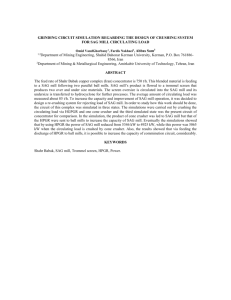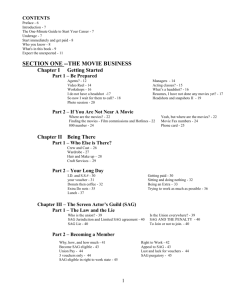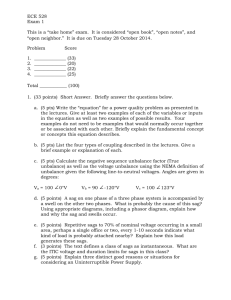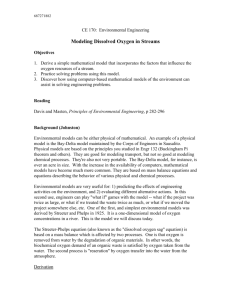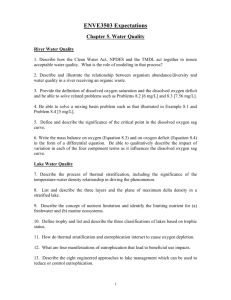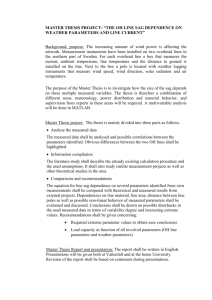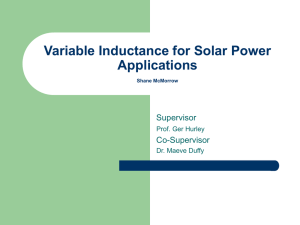CITY OF TORONTO: LONG-TERM WASTE MANAGEMENT
advertisement
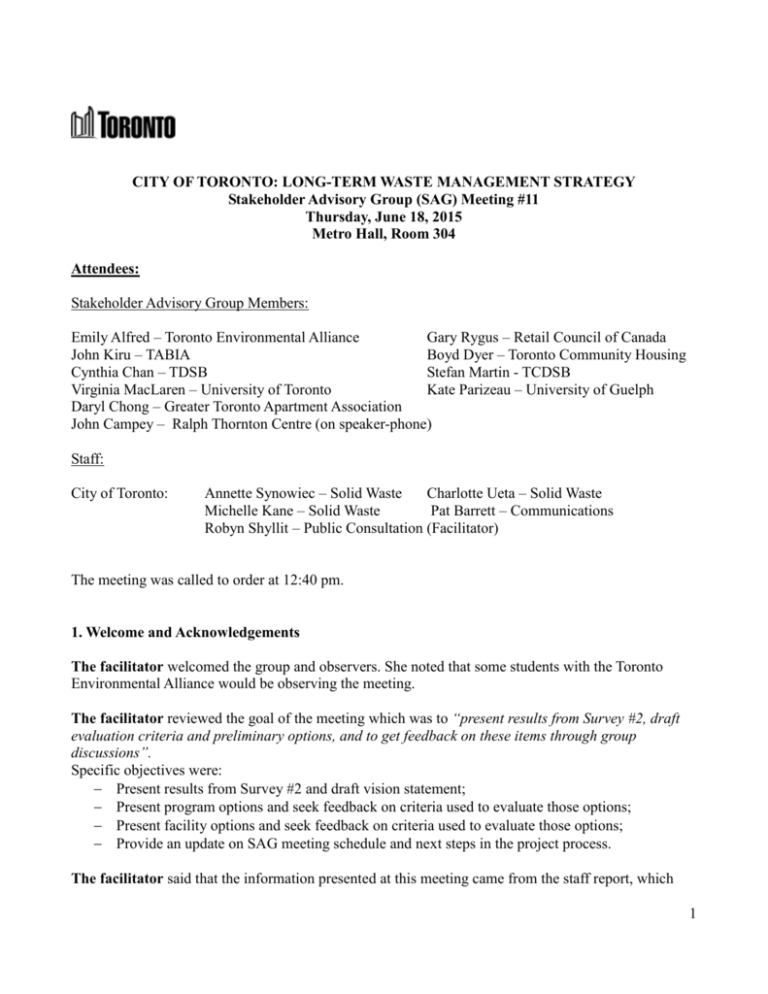
CITY OF TORONTO: LONG-TERM WASTE MANAGEMENT STRATEGY Stakeholder Advisory Group (SAG) Meeting #11 Thursday, June 18, 2015 Metro Hall, Room 304 Attendees: Stakeholder Advisory Group Members: Emily Alfred – Toronto Environmental Alliance Gary Rygus – Retail Council of Canada John Kiru – TABIA Boyd Dyer – Toronto Community Housing Cynthia Chan – TDSB Stefan Martin - TCDSB Virginia MacLaren – University of Toronto Kate Parizeau – University of Guelph Daryl Chong – Greater Toronto Apartment Association John Campey – Ralph Thornton Centre (on speaker-phone) Staff: City of Toronto: Annette Synowiec – Solid Waste Charlotte Ueta – Solid Waste Michelle Kane – Solid Waste Pat Barrett – Communications Robyn Shyllit – Public Consultation (Facilitator) The meeting was called to order at 12:40 pm. 1. Welcome and Acknowledgements The facilitator welcomed the group and observers. She noted that some students with the Toronto Environmental Alliance would be observing the meeting. The facilitator reviewed the goal of the meeting which was to “present results from Survey #2, draft evaluation criteria and preliminary options, and to get feedback on these items through group discussions”. Specific objectives were: Present results from Survey #2 and draft vision statement; Present program options and seek feedback on criteria used to evaluate those options; Present facility options and seek feedback on criteria used to evaluate those options; Provide an update on SAG meeting schedule and next steps in the project process. The facilitator said that the information presented at this meeting came from the staff report, which 1 would go a bit deeper than the information being presented at the PICs (Public Information Centres, two of which had already occurred). The feedback from today's meeting and the PICs would inform the next staff report being prepared for September. 2. Survey #2 – Draft Vision Statement; Program Options and Criteria – group discussion Charlotte Ueta presented on the results from Survey #2. She said that the team was in the middle of the consultation phase, which is pivotal to the Strategy. Along with the SAG, there is also consultation going on through the PICs, key stakeholders, and the surveys. Some of the presentation would be familiar because the content of the survey was presented at the last meeting by webinar, but this meeting would go into greater detail. The following is a summary and captures discussion surrounding the presentation. Charlotte Ueta said that Survey #2 closed on May 29, and there were about 800 responses, which was considered quite good. Vision Statement & Guiding Principles: Charlotte Ueta identified the purpose of the Vision Statement and Guiding Principles. Vision Statement: These slides showed which concepts were most and least important to those responding to the survey. The most important was “taking responsibility for our own waste by focusing on reducing on the amount of waste generated”. This was followed by “embracing a waste management system that is user friendly and convenient”. The least important was “Toronto being an international leader”, followed by “opportunities for leadership, collaboration and innovation”. Charlotte Ueta said that this showed that respondents were not so concerned about how Toronto compares to others, but what Toronto should do to manage its own waste. A SAG member asked whether the issue of taking responsibility referred to individual responsibility or the City taking responsibility for its own waste. Charlotte Ueta said that it could be a bit of both. A SAG member asked whether people could answer multiple options. Charlotte Ueta said that people could select their three most important, and their one least important option. A SAG member asked whether there are any details about the demographics of respondents. Charlotte Ueta said that the last part of the survey collected some demographic information, including the type of housing and where in the City the respondents live, age, and some other questions. The SAG member asked what kind of differences in environmental attitudes were evident according to where people live within the City. Charlotte Ueta said the team could look into that, break down the data and get back to the SAG. A SAG member said that she would like to know what kind of alternative visions were provided in the Survey. Charlotte Ueta said the team could provide that. Draft Vision Statement: This Statement will be taken to PWIC and Council in September and October 2 respectively, for final approval. The facilitator asked if there were any more reflections on it. A SAG member said that the first sentence did not read very well. He also thought the group had agreed not to use the word “waste”. Another SAG member said that the group had talked about it, but she was not sure that it had been agreed not to use it. She said that RCO had objected to the term but she did not think that the group had come to a conclusion. Charlotte Ueta said the point could be noted and considered before the Statement is submitted. A SAG member asked what term the public most identifies with. He thought that whatever is most understandable to the public should be used, unless the goal is to redefine that public definition. Pat Barrett said the City has tended to use “waste” as an umbrella term that covers garbage, recyclables, and organics. That is the approach that has been taken in the public education literature. A SAG member asked whether the project team is reaching out primarily to citizens of the City or to businesses and other municipal users as well. Charlotte Ueta said that it will include all stakeholders. Survey #2 – Guiding Principles: Charlotte Ueta said that the top principle from the Survey was “work to mitigate climate change”, followed by “treat waste as a resource”. A SAG member said that he hoped that the City is not trying to do this in isolation from the Province, which is going to be working on new waste legislation in the fall. He would like to see consistency. Charlotte Ueta said the Ministry of Environment and Climate Change is aware that Toronto is doing the Strategy, and the General Manager will be meeting with them about this as well. A SAG member said that what struck her is that the top 3 principles were about health and the environment, whereas economics was lower down. Evaluation Process: Charlotte Ueta said that the SAG had seen a presentation of this in April. She planned to provide a high level explanation of the process and then to go into the options. She said that the evaluation process would have three phases: Background Data Collection; Application of Evaluation Criteria; and Recommendation of Preferred Options. A SAG member asked, regarding slide 11, who would be doing the final evaluation. Charlotte Ueta said that the background data collection would be by the consultants, the feedback would come from the SAG, the PICs, the Survey, and Council, and the evaluation would be done by the consulting team based on the feedback received on criteria. Michelle Kane added that no evaluation would take place until after Council approves the criteria. Charlotte Ueta then presented on Preliminary Program Options. A SAG member asked about the use of garburators. He said that some municipalities had banned their use. Charlotte Ueta said that she would ask the consultants to provide more clarification on that option. Another SAG member said that York Region rescinded their ban on garburators. A SAG member said that it is still not clear how the criteria are going to be applied. She was not clear how the options would be compared to the others. Charlotte Ueta said that the entire list of options would be run through the evaluation process. The SAG member asked whether it is not so important 3 then which heading an option is under. Charlotte Ueta said that she will verify and follow up. Another SAG member said that there are very few options that should not be kept. Charlotte Ueta noted that there are about 60 options and several criteria. Another SAG member agreed, and said that some of the options are so obviously good, it is more about how they fit in the Strategy, rather than if they fit. She thought that some would worth evaluating, but some, like increased social media presence, are so obvious that it would not be worth putting them through the evaluation. Some other SAG members noted that there are some options which certainly should be evaluated, but not necessarily all. Charlotte Ueta said that the evaluation and ranking would also help to prioritize on how to move forward with the 10 year reduction plan. A SAG member said that some of the options would require staff time, some would require money in different amounts depending on how fulsome the programming is. She thought it would be hard to provide input without knowing the criteria. Another SAG member said that it seemed like some of the options were good ideas, but things like a tool library could be competing with a business. He thought that should be considered. Some SAG members communicated to the facilitator that they wanted to see the evaluation criteria before discussing the options further. Charlotte Ueta presented on Program Evaluation Criteria. A SAG member mentioned that there is a City of Toronto initiative to get large buildings to track energy. He asked how that would be linked with this, as he was concerned that without integration and coordination, businesses would find it extremely difficult to report different things to a whole bunch of different agencies. Charlotte Ueta said she thought this could be considered at the Executive Environment Team, which includes other City divisions. They are considered key stakeholders and the team will seek their input. She said the team wants to ensure synergy. Robyn Shyllit handed out the workbook on the criteria and invited the group to discuss the program options and criteria. A SAG member said that it was still not clear how the criteria would be ranked. There were just two environmental criteria, and lots of social and financial criteria. She wanted to know how they would be weighed against each other and applied. Charlotte Ueta said that this will be followed up on and will provide a response. Another SAG member said that the public input had shown prioritization of environmental concerns but there were just two environmental criteria and lots of social and economic criteria. She asked how that tied in to the community's response in Survey #2. Also, the community said that innovation wasn't so important, but innovation was still one of the criteria. She asked how that would rank against the environmental criteria. Another SAG member said that health should be mentioned somewhere within the criteria. 4 Another SAG member said that something like a community food waste program would be hardpressed to be well evaluated by these criteria. She said that the group had talked about local jobs. Perhaps this would indicate an increase in social equity. A SAG member said that the criteria looked very much the same as what had been discussed at the April SAG meeting. It didn't seem to incorporate the feedback that the SAG provided last time. She felt that this conversation would just be a repeat of the earlier conversation. Charlotte Ueta said that was fair feedback and noted that their feedback on the criteria would be incorporated in the next staff report in September. Another SAG member said that she thought there should be a criterion to ensure that options do not unfairly impact those with lower income, the elderly, etc. That had been mentioned before but it is not in the criteria. Another SAG member said that he was trying to understand the innovation piece. He wanted to know what is meant by that. Some of the innovation might be outside of North America. He wanted to know what that would mean for this. A SAG member reiterated her frustration that the feedback the SAG had not yet provided in April was not reflected in the criteria being presented. Michelle Kane said she did not want people to think all the great feedback from the April meeting will not be taken into consideration. It will certainly be considered along with feedback received from other stakeholders. A SAG member asked whether they would need to make the same comments again at this meeting. Michelle Kane said no. The SAG member said that seemed to be the route being taken at this meeting. Charlotte Ueta said today's discussion is also includes the indicators, which was not presented at the April meeting. A SAG member said that she did not see indicators being presented. An indicator would be something like a specified number of parts per million of air pollution, rather than “adding pollution to air”. It would include a threshold or a standard. It would include more metrics. Another SAG member said that “innovation potential” is not an indicator. She also said that the waste hierarchy is in social and should be in environmental criteria. She was also confused by “potential to increase diversion”. She did not know how the indicator presented for this would actually give a higher score to something that is higher on the waste hierarchy. Charlotte Ueta asked whether the SAG had enough information from what was presented to rank them. A SAG member asked why it would be necessary to rank them. She asked if that meant things would be weighted more if they were ranked higher. The facilitator took the discussion back to the list of options. Comments on each option are listed under each slide title. Generation, Reduce and Reuse: 5 A SAG member said that tool sharing is a good idea to save people money, but it doesn't seem like something that is going to have a major impact on landfill. He felt the same way about an art exchange – it is a good way to save money, but if it wasn't there, he thought people would use Kijiji to sell them. He did not think most people would throw these items in the landfill if they were finished with them. Another SAG member responded that there are people who buy a home and don't buy tools because there is a tool share library. She thought it was more about building a culture of conservation and sharing. It also gives more people access to top quality tools. As long as it isn't very expensive and it does not take away from other options, she thought they were a good idea. The first SAG member asked whether Car Sharing should be on the list then. It is the same logic. He said he did not mind leaving it in, but it did not seem to have much impact. A third SAG member said that it did seem very specific. She would like to see a more general “reuse” strategy. A SAG member said that it is hard to see all the options in the same bucket. Different options require different resources, time and money. Comparing a food waste strategy to a tool library is very hard. It also implies the City will do one and not the other, but really the City will do policy, outreach etc. She suggested categorizing them: comparing policy options to each other, program options to each other, etc. Another SAG member agreed. She said creating a reuse strategy to include everything (kitchen tools, bike tools, building materials) would be very exciting. Another SAG member asked whether the end game is to reduce what is going into landfill. Charlotte Ueta said yes. The SAG member said that the plastic bag levy addressed less than 1% of the waste stream. He thought the same applies to tools and art supplies. He asked about things that have more bang for the buck. Another SAG member said the low-hanging fruit have already been addressed. She said that what's left are lots of little things. A third SAG member said he thought that Industrial, Commercial & Institutional (IC&I) was the biggest low-hanging fruit left. Charlotte Ueta said this was a good segue to the next slide. Overall System Considerations – IC&I A SAG member asked where the City is going on IC&I. He thought nobody in the City is touching it. Charlotte Ueta said that one of the City's assets is the landfill, and the City has raised tipping fees and is trying to move away from non-Toronto customers. A SAG member said that this is a good example of comparable options that can be weighed against each other. She also pointed out that there is a tension between the options here and getting more or less into the multi-res system. Overall System Considerations – Other A SAG member said that multi-res is the big growth industry for diversion. The City is trying to get the numbers higher, but won't get them higher without making it more convenient. Charlotte Ueta recalled stakeholder feedback relating to building guidelines and retrofits of trisorters. The SAG member said that trisorters don't work – there need to be 3 chutes side by side. Another SAG member agreed, and said that there absolutely should be development guidelines about that. The first SAG 6 member said there will be resistance from the development industry because it triples the footprint of the system. The other SAG member agreed but still thought it was necessary. Another SAG member said that there is a City requirement that recycling has to be as convenient as garbage disposal, but the question is how that is interpreted. A SAG member described a new building near City Hall which has no chutes, so it is equally convenient to dispose of all materials. If people have to take the materials down anyway, they usually decide to dispose of them properly. Another SAG member said that she liked exploring mechanisms like bans, levies bylaws and acts, but it depended on which. She thought some would be easy and some would not. Another SAG member asked what “discontinue provision of multi-residential waste services” meant. Charlotte Ueta said it would mean the City would get out of the business of providing multi-res collection, and multi-residential properties would have to negotiate their own contracts. A SAG member said he'd love that. Promotion and Education A SAG member said that there are some other ideas that are not on the list. She suggested TV, media campaigns, presence at festivals, and partnering with other diverse news organizations. There were no comments on Promotion and Education – Multi-Res. Recycling and Processing A SAG member asked what on-site organics processing is. Michelle Kane said it is a small scale organics process that happens in a vessel on-site, ORCA is one example. The bacteria consume much of the solids and the residual is liquid that is sent to the sewage treatment plant. It can be indoors in the basement. Charlotte Ueta said the team can provide more information on that option. Another SAG member suggested an additional criterion should be consideration of effect on infrastructure. The consulting team must talk to Toronto Water about the implications of systems that send residual into the sewage treatment system. Another SAG member said it is related to grease trap issues where sewer grease is reducing the internal diameter of the sewers. A third SAG member said that perhaps a screening criterion should remove options that are inoperable (e.g. that don't meet provincial law, etc). A SAG member asked whether a time would come when there would be simply an organics and a dry stream and the MRF does the rest of the sorting. He said that there is so much confusion leading to contamination of the recycling stream and recyclables going into the garbage stream. Charlotte Ueta said that a dirty MRF is one of the facility options. The SAG took a 10 minute break. 3. Facility Options and Criteria – group discussion 7 Charlotte Ueta presented on Facility Options and Criteria. She said that two categories had been removed. The first was about transfer station options, because at the last SAG meeting it had been decided that the issue was too internally focused and would be hard for the public to provide proper comments on. The same applied to asset management. The group would therefore be looking at four options. The following is a summary and captures discussion surrounding the presentation. The discussion covers both the options and the criteria. Collection and Drop-Off: A SAG member asked for clarification about drop-off facilities. She asked if this meant a truck coming to get these items, or providing a container. A SAG member asked if the mobile service would be manned or not. There may be liability issues, and that would need to be managed. Charlotte Ueta said that without getting to that level of detail now, that would have to be taken into consideration when these are being evaluated. A SAG member said that a lot of things that the City recycles are not easy for people to drop off, or certain customers are not eligible for collection. She suggested expanding all waste diversion programs to all customers. Another SAG member agreed that it would be good to have access to all programs (e.g. yard waste for schools; battery collection for schools). There have been concerns about safety for drop-off locations for batteries, so when there is collection, it is done for events. A SAG member asked if the City is looking at a hybrid system for dirty MRFs. He said that the waste stream from schools is mostly composting and recycling, but most goes to landfill. It would be better to have a dry stream and a composting stream. Charlotte Ueta said that the consultant could consider that as well, and consider which customer group it would be applied to. Recovery: A SAG member said that anaerobic digestion from composting should not be in disposal. It should be higher up in the hierarchy. Charlotte Ueta said that change will be made based on the comments received. Recovery – Energy from Waste: A SAG member suggested that landfill gas recovery should be under "Recovery - energy from waste". A SAG member said that in some of these cases, the situations are “either-or”, and in others the options are to happen in tandem with each other. The interactions between these options need to be thought about more carefully. Charlotte Ueta said that was a good point and would be taken back. A SAG member suggested that when combinations are possible, the interactions between them need to also be considered. One option on its own might not look so good but in combination with another may 8 be more worthwhile. A SAG member asked how this would fit with siting. She suggested a screening criterion to decide if there is a place where a facility could be sited in the City. Another SAG member asked whether that would fit into approvals complexity. Charlotte Ueta said that could be clarified. The first SAG member said that the liabilities associated with these facilities is closely related to where they are sited. A SAG member asked about the difference between a bioreactor and a biocell and why they are categorized differently. Charlotte Ueta said that she will follow up to provide those details. Residual Disposal: A SAG member asked if developing a new landfill is not on the table. Charlotte Ueta said that it could fall under the option “purchasing a new landfill”. The SAG member said that sounded like purchasing an existing one. Charlotte Ueta said that could be made clearer. System Financing: A SAG member wanted to point out that many of these options are very controversial and there is conflicting data about them. She asked if the consultants would show the inputs that are used. Charlotte Ueta said it could be something to consider in criteria and indicators. A SAG member asked whether the incentive for multi-res would go back to the building owner or the residents. Charlotte Ueta suggested that perhaps it would go to the program users. The SAG member said that it would not be easy but it would be more likely to get a response. Another SAG member said that she saw performance-based incentives more as a program-based option rather than as a financing tool. A SAG member said that the team was looking at increasing the customer base but hadn't yet decided if the City would provide the service or not. Charlotte Ueta agreed that that was consistent with the earlier comment about how things impact each other. A SAG member said that regarding allocating costs for waste management, the City would reduce the incentive to divert if it removes that rebate. Another SAG member said that she heard that Vancouver now charges for all three streams. She suggested that the team could find out how things work there. A SAG member asked if there will be an analysis about cost recovery, like for the Yellow Bag program and the IC&I sector. Depending on whether there is a profit or loss on it, it might help to finance the system. A SAG member said that it would be interesting to see how people respond to this because it is very confusing. Those who live in multi-residential buildings may not even know about the rebate program. Charlotte Ueta asked if there should be any additional criteria. A SAG member said that the group already gave input at the earlier SAG and that they did not feel the need to provide additional 9 comments on the criteria. 4. SAG Meeting Schedule Charlotte Ueta said that this is the last meeting until September. The next report is going to be crucial, taking all the input from the public, SAG, key stakeholders and councillors, and considering it. It will go to Public Works and Infrastructure Committee in September, and then seeking Council approval in October. A SAG member suggested that before October, it would be useful to have a meeting with the consultants about how they have used the feedback from this group, and if they haven't used it, why not. She said that the SAG would like some feedback. Another SAG member said that this should also include an explanation about how these criteria would be applied. It is hard to understand future steps. It must be transparent how the criteria will be used. A SAG member said that she would like to get the information in advance of the October meeting, in order to prepare for it. Annette Synowiec said that in September it will be a bigger list. There will be no application of criteria until there is approval that the list is comprehensive. She reassured the group that the project team would come back to the SAG with that information. A SAG member asked if the Phase 3 would be complete by the February meeting. Charlotte Ueta said there would be initial feedback. A SAG member asked to talk about scheduling of meetings. Michelle Kane said she would do another Doodle poll for September onwards. 5. Meeting #10 Follow Up, Circle Back and Next Steps A SAG member said that all the information presented at this meeting is great if the City works in a bubble. The Province will get into this in the fall with new legislation, so the project team should craft a buffer to deal with that. Annette Synowiec said that the possibility of legislative changes was included in the plan for the Strategy. If the City had any positions regarding the legislation, that would be a separate report, but the Waste Strategy would tie in to that. Robyn Shyllit reminded the group that the Strategy is in the middle of the public consultation phase, and requested that they send anyone they knew to be interested to participate in the remaining PICs or to the online Survey. She also said the next instalment of the speaker series would be coming up. The facilitator thanked the group for their participation. The meeting was adjourned at 3:01 pm.10 10

